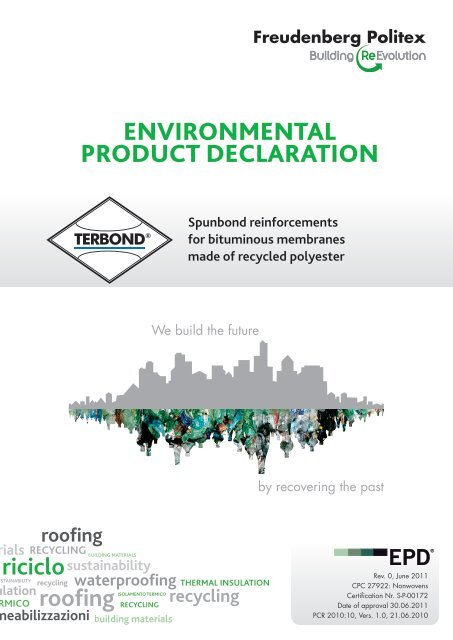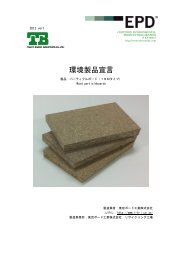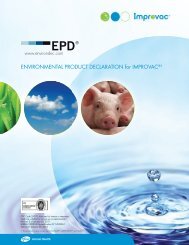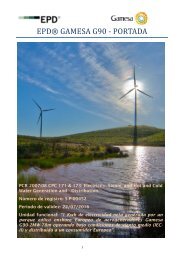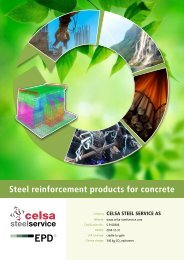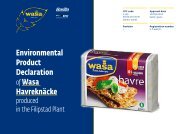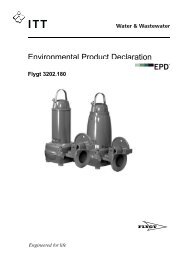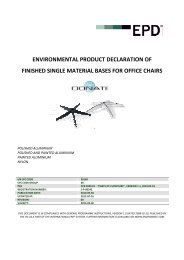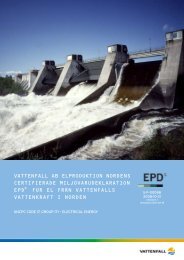Spunbond reinforcements for bituminous membranes made of ...
Spunbond reinforcements for bituminous membranes made of ...
Spunbond reinforcements for bituminous membranes made of ...
You also want an ePaper? Increase the reach of your titles
YUMPU automatically turns print PDFs into web optimized ePapers that Google loves.
ENVIRONMENTAL<br />
PRODUCT DECLARATION<br />
<strong>Spunbond</strong> <strong>rein<strong>for</strong>cements</strong><br />
<strong>for</strong> <strong>bituminous</strong> <strong>membranes</strong><br />
<strong>made</strong> <strong>of</strong> recycled polyester<br />
Rev. 0, June 2011<br />
CPC 27922: Nonwovens<br />
Certification Nr. S-P-00172<br />
Date <strong>of</strong> approval 30.06.2011<br />
PCR 2010:10, Vers. 1.0, 21.06.2010
Environmental<br />
Product<br />
Declaration<br />
1. DESCRIPTION OF THE COMPANY AND OF THE PRODUCT<br />
1.1 The Group<br />
Freudenberg Politex is a multinational with its headquarters in Italy at Novedrate (Como). The<br />
Group’s core business is the production <strong>of</strong> polyester nonwovens, <strong>made</strong> using both staple and<br />
spunbonded technology.<br />
The main market <strong>of</strong> the Group is the construction sector, where nonwovens <strong>of</strong> the Ro<strong>of</strong>ing<br />
division are sold as rein<strong>for</strong>cement <strong>for</strong> <strong>bituminous</strong> <strong>membranes</strong> <strong>for</strong> ro<strong>of</strong>s waterpro<strong>of</strong>ing. The<br />
Construction Materials division includes a complete range <strong>of</strong> finished products <strong>for</strong> different<br />
applications: thermal insulation, acoustic insulation, underfloor soundpro<strong>of</strong>ing, waterpro<strong>of</strong>ing,<br />
rein<strong>for</strong>cement <strong>for</strong> walls and roads, underslating protection and geotextiles.<br />
Completing the Group’s products portfolio are Voluminous Nonwovens used as padding in<br />
the furniture and clothing industries.<br />
The majority <strong>of</strong> Freudenberg Politex products are manufactured using recycled raw materials,<br />
recovered and upgraded in-house, thanks to vertically integrated processes. The production <strong>of</strong><br />
polyester starts with the recycling <strong>of</strong> post-consumer PET bottles, which are sorted, washed and<br />
ground to flakes. The flakes are then used in the production <strong>of</strong> fiber or directly in the spunbond<br />
process.<br />
Freudenberg Politex belongs to the Freudenberg Group (Weinheim, Germany), which<br />
comprises 16 Business Groups operating independently on various markets all over the world.<br />
1.2 The production sites<br />
Freudenberg Politex, with an organizational structure capable <strong>of</strong> creating products to meet the<br />
needs <strong>of</strong> diverse markets around the world, operates out <strong>of</strong> six production sites: three in Italy,<br />
with two plants at Novedrate (Como) and one at Pisticci (Matera), one in France at Colmar, one<br />
in Russia in Nizhniy Novgorod and one in the United States at Macon (Georgia). Completing<br />
the organization <strong>of</strong> the Group are two trading companies in China at Shanghai and in Poland at<br />
Lodz and a comprehensive sales network.<br />
1.3 Responsibility and the Environment<br />
Freudenberg Politex Group operations obtained the following certifications:<br />
ISO 9001 – Quality Management System<br />
ISO 14001 – Environmental Management System<br />
OHSAS 18001 – Health and Safety Management System<br />
In Italy the Group joined Responsible Care, the voluntary programme <strong>of</strong> the global chemical<br />
industry, under which businesses commit themselves to the continuous improvement <strong>of</strong><br />
products, processes and behaviour in the areas <strong>of</strong> Safety, Health and the Environment, in<br />
order to give a significant contribution to the sustainable development <strong>of</strong> industry, local<br />
communities and society.<br />
All companies in the Freudenberg Politex Group adopt Corporate Governance rules and<br />
Guiding Principles (www.freudenbergpolitex.com), highlighting responsibility with regard to<br />
People, the Environment and Safety in all fields <strong>of</strong> activity.<br />
www.freudenbergpolitex.com Page 2 <strong>of</strong> 10
Environmental<br />
Product<br />
Declaration<br />
1.4 The product<br />
Terbond ® is a range <strong>of</strong> polyester fiber nonwovens manufactured with spunbond technology,<br />
available in numerous weights capable <strong>of</strong> meeting a wide range <strong>of</strong> technical requirements to<br />
satisfy the different needs <strong>of</strong> global markets.<br />
The fiber used is produced in-house by Freudenberg Politex through the recycling <strong>of</strong> postconsumer<br />
PET bottles.<br />
The EPD is based on Terbond ® family produced in Colmar (France) and Pisticci (Italy) taking<br />
into account a weighted average <strong>of</strong> the production in<strong>for</strong>mation <strong>of</strong> the two sites during the 2010.<br />
The final application <strong>of</strong> Terbond ® nonwovens is the <strong>bituminous</strong> membrane, obtained from the<br />
process <strong>of</strong> bitumen impregnation at the production sites <strong>of</strong> membrane manufactures and then<br />
used <strong>for</strong> the waterpro<strong>of</strong>ing <strong>of</strong> ro<strong>of</strong>s. For the LCA study <strong>of</strong> the finished product reference has to<br />
be <strong>made</strong> to any analysis carried out by <strong>bituminous</strong> <strong>membranes</strong> manufacturers.<br />
The different variations <strong>of</strong> finishing and <strong>of</strong> weight <strong>of</strong> Terbond ® products are aimed at satisfying<br />
a wide range <strong>of</strong> technical requirements, in order to meet the demands <strong>of</strong> global markets:<br />
Needlepunched spunbond nonwovens<br />
Production: Colmar (France)<br />
Terbond ® different types <strong>of</strong> weight and thickness:<br />
Weight<br />
Needlepunched and chemical bonded spunbond nonwovens<br />
Production: Pisticci (Italy) and Colmar (France)<br />
Needlepunched and thermal bonded spunbond nonwovens<br />
Production: Colmar (France)<br />
Needlepunched spunbond nonwovens rein<strong>for</strong>ced with glass filaments<br />
Production: Pisticci (Italy)<br />
Terbond Terbond A Terbond TH Terbond R U.o.M.<br />
from 150 to 300 from 50 to 250 from 100 to 250 g/m 2<br />
from 120 to 270<br />
Thickness from 1,00 to 1,50 from 0,60 to 0,85 from 0,50 to 1,00 from 0,70 to 1,30 mm<br />
www.freudenbergpolitex.com Page 3 <strong>of</strong> 10
Environmental<br />
Product<br />
Declaration<br />
This EPD is based on the LCA study carried out on Terbond ® products with average weight <strong>of</strong><br />
150 g/m2:<br />
Weight<br />
Thickness<br />
Tensile strength<br />
at break<br />
Elongation at break ISO 9073-3<br />
Terbond 150 Terbond A 150 Terbond TH 150 Terbond R 150 U.o.M.<br />
ISO 9073-1 150<br />
150<br />
ISO 9073-2 1,00<br />
0,68 0,64<br />
0,85<br />
mm<br />
ISO 9073-3<br />
MD 58 50 43 50<br />
CD 41 47 43 36<br />
MD 30 52 30 25<br />
CD 30 58 30 30<br />
1.5 Composition <strong>of</strong> the product<br />
Terbond ® : 79% recycled polyester 21% resins and additives<br />
Terbond ® A: 45% recycled polyester 55% virgin polyester<br />
Terbond ® TH: 39% recycled polyester 61% virgin polyester<br />
Terbond ® R: 78% recycled polyester 18% resins and additives<br />
4% glass filaments<br />
2. ENVIRONMENTAL PERFORMANCE DECLARATION<br />
www.freudenbergpolitex.com Page 4 <strong>of</strong> 10<br />
150<br />
150<br />
g/m 2<br />
daN / 5 cm<br />
The results represented below are based on the Life Cycle Assessment (LCA) study carried<br />
out on the products Terbond ® , Terbond ® A, Terbond ® TH and Terbond ® R with the aim to<br />
in<strong>for</strong>m the public and the interested parties about the environmental per<strong>for</strong>mance <strong>of</strong> its<br />
production process.<br />
The methodology used follows the rules described in the standard ISO 14044:2006, in line with<br />
the International EPD System.<br />
The reasons <strong>of</strong> the LCA study arose from the need to have a precise processes accounting<br />
and to highlight potential improvements that could be started in order to increase the<br />
environmental, energetic and economic efficiency and effectiveness <strong>of</strong> the processes. In<br />
addition the purpose was to quantify and to communicate the environmental advantages<br />
deriving from the use <strong>of</strong> non virgin raw material.<br />
2.1 The Evaluation Method<br />
The assessment <strong>of</strong> environmental per<strong>for</strong>mance was carried out according to the PCR 2010:10<br />
“Product Category Rules (PCR) <strong>for</strong> the assessment <strong>of</strong> the environmental per<strong>for</strong>mance <strong>of</strong> UN<br />
CPC 27922, Nonwovens <strong>for</strong> different purposes other than clothing” and to the “General<br />
Programme Instructions <strong>for</strong> Environmental Product Declaration”.<br />
2.2 The Functional Unit<br />
The functional unit is represented by 1 kg <strong>of</strong> Terbond ® family.<br />
The environmental in<strong>for</strong>mation is represented with surface unit 1 m 2 .<br />
2.3 The System Boundaries<br />
The life cycle <strong>of</strong> Terbond ® products includes Upstream, Core and Downstream processes (Fig.<br />
1). The system boundary determines those unitary processes which have to be included in the<br />
LCA study.<br />
%
Environmental<br />
Product<br />
Declaration<br />
Upstream Processes include:<br />
· extraction and production <strong>of</strong> raw materials;<br />
· manufacturing <strong>of</strong> semi-finished goods;<br />
· manufacturing <strong>of</strong> additives (caustic soda, floating, surface-active, etc.);<br />
· production processes <strong>for</strong> components and packaging (PE bags, labels, PE film);<br />
· process <strong>of</strong> post-consumer PET bottles collection and selection;<br />
· transport <strong>of</strong> post-consumer PET bottles from the selection plant to the factory;<br />
· internal process <strong>of</strong> recycling <strong>of</strong> post-consumer PET bottles.<br />
Core Processes include:<br />
· transports: from the supply <strong>of</strong> semi-finished goods and <strong>of</strong> consumables to the conveyance to<br />
landfill or waste recovery;<br />
· internal transports;<br />
· transport <strong>of</strong> post-consumer PET bottles from the selection plant to the factory;<br />
· manufacturing processes <strong>for</strong> the production <strong>of</strong> Terbond ® products: spinning and web <strong>for</strong>mation,<br />
mechanical bonding (needling), thermal or chemical bonding, winding and storage;<br />
· packaging <strong>of</strong> Terbond ® product family;<br />
· consumption <strong>of</strong> water and energy.<br />
Downstream Processes including distribution, use and end <strong>of</strong> life management, have been<br />
considered from a qualitative point <strong>of</strong> view because <strong>of</strong> the impossibility to outline a realistic<br />
reference scenario with appropriate data.<br />
Refuses and waste water treatment are excluded from the system.<br />
PET bottle<br />
selection<br />
Transport and<br />
bottles storage<br />
and loading<br />
PET flakes<br />
drying and<br />
storage<br />
PET flakes<br />
crystallization<br />
and drying<br />
Terbond ® Terbond R<br />
Glass<br />
rein<strong>for</strong>cement<br />
® R<br />
Glass<br />
rein<strong>for</strong>cement<br />
Recycling or<br />
disposal<br />
Bottles collection<br />
center<br />
Bottles prewashing<br />
PE floatation,<br />
dewatering and<br />
sieving<br />
Extrusion,<br />
spinning and<br />
web <strong>for</strong>ming<br />
Terbond ® Terbond TH<br />
Thermal bonding<br />
® TH<br />
Thermal bonding<br />
Use <strong>for</strong><br />
waterpro<strong>of</strong>ing <strong>of</strong><br />
ro<strong>of</strong>s<br />
Upstream Processes<br />
Core Processes<br />
Detection <strong>of</strong><br />
<strong>for</strong>eign materials<br />
Washing<br />
Needling<br />
Terbond ® Terbond A<br />
Heat setting<br />
® A<br />
Heat setting<br />
Rolls winding<br />
and storage<br />
Downstream Processes<br />
Production <strong>of</strong><br />
<strong>bituminous</strong><br />
<strong>membranes</strong><br />
Production <strong>of</strong><br />
other materials<br />
Bottles grinding<br />
PE floatation and<br />
flakes washing<br />
Terbond ® Terbond ®<br />
Chemical bonding<br />
Transport to<br />
<strong>membranes</strong><br />
manufacturers<br />
External processes Recycling plant Spun production plant<br />
Figure 1. Scheme <strong>of</strong> the production process <strong>of</strong> Terbond ® product family<br />
www.freudenbergpolitex.com Page 5 <strong>of</strong> 10
Environmental<br />
Product<br />
Declaration<br />
2.4 Cut-<strong>of</strong>f and allocation principles<br />
The processes contributing <strong>for</strong> less than 1% <strong>of</strong> the total environmental impact <strong>for</strong> each impact<br />
category have been omitted from the inventory. Where possible, the allocation is avoided or it<br />
follows a procedure based on the mass balance <strong>of</strong> the output products (see Table 1).<br />
2.5 Data Quality<br />
Data refer to the year 2010 and were collected in Freudenberg Politex plant located in Colmar<br />
(France) and Pisticci (Italy). The study was also based on the data from SimaPro ver. 7.2.3:<br />
Ecoinvent 2.2.<br />
The contribution <strong>of</strong> the other generic data to each impact category is below 10%.<br />
Data concerning energy aspects refers to the energy mix <strong>of</strong> the French site in Colmar and the<br />
production process <strong>for</strong> the electrical energy from palm oil in Pisticci.<br />
The data collection was conducted in compliance with the two modalities contained in the ISO<br />
14044:2006.<br />
2.6 Environmental pr<strong>of</strong>ile <strong>of</strong> the product<br />
To have univocal environmental in<strong>for</strong>mation and in order to support decisions about the use <strong>of</strong><br />
eco-sustainable materials, the impact categories have been analyzed in line with what<br />
requested by the indications <strong>of</strong> the Environmental Product Declaration (EPD) and referred to<br />
the production process illustrated in Figure 1. For the production <strong>of</strong> 1 kg Terbond ® the inflow<br />
material (mainly PET bottles post-consumer) in the system goes through the bottles recycling<br />
plant and the spun production department. Table 1 shows the environmental per<strong>for</strong>mance<br />
relevant to the production <strong>of</strong> Terbond ® product family divided into in<strong>for</strong>mation about natural<br />
resources consumed (energetic and non).<br />
Energy resources (used <strong>for</strong> energy<br />
conversion purposes)<br />
Material resources<br />
Resources consumption<br />
Renewable<br />
Nonrenewable<br />
Upstream Processes Core Processes Terbond<br />
1 kg 1 kg<br />
® TOTAL<br />
1 kg<br />
A TH R A TH R A TH R<br />
Biomass g 38,33 18,05 19,42 183,13 621,31 9,36 10,51 1965,87 659,64 27,41 29,92 2149,00<br />
Biomass MJ 0,65 0,31 0,37 3,11 10,53 0,16 0,14 33,31 11,18 0,46 0,51 36,42<br />
Hydroelectric MJ 0,18 0,50 0,58 0,18 0,47 1,30 1,16 0,24 0,66 1,80 1,73 0,42<br />
Wind MJ 0,01 0,06 0,07 0,02 0,01 0,02 0,02 0,01 0,02 0,08 0,09 0,03<br />
Solar MJ 0,00 0,00 0,00 0,00 0,00 0,00 0,00 0,00 0,00 0,00 0,00 0,00<br />
Total MJ 0,84 0,87 1,01 3,31 11,01 1,48 1,31 33,56 11,86 2,35 2,33 36,87<br />
Coal g 75,40 277,43 326,41 100,39 40,99 85,17 76,00 42,21 116,39 362,60 402,40 142,60<br />
Oil g 105,43 138,16 156,03 107,53 47,43 14,42 18,14 130,49 152,86 152,58 174,16 238,02<br />
Uranium g 0,00 0,01 21,59 0,00 0,02 0,06 0,05 0,00 0,02 0,06 21,64 0,01<br />
Gas g 124,31 120,16 164,43 195,22 36,31 20,30 15,90 208,20 160,61 140,46 180,33 403,42<br />
Total g 305,14 535,77 668,46 403,14 124,75 119,95 110,08 380,90 429,89 655,71 778,54 784,04<br />
Coal MJ 1,13 3,99 4,71 1,45 0,70 1,59 1,42 0,60 1,83 5,58 6,14 2,05<br />
Oil MJ 8,92 19,97 21,87 8,64 1,04 0,66 0,83 2,26 9,96 20,64 22,70 10,90<br />
Uranium MJ 2,68 5,14 5,52 1,59 9,85 31,02 27,61 1,33 12,53 36,17 33,13 2,92<br />
Gas MJ 12,82 17,13 20,39 15,88 5,16 1,10 0,86 5,60 17,99 18,23 21,25 21,48<br />
Total MJ 25,55 46,24 52,50 27,56 16,76 34,37 30,72 9,79 42,31 80,61 83,22 37,35<br />
there<strong>of</strong> electricity consumption kWh - - - - 0,99 2,19 1,90 2,30 0,99 2,19 1,90 2,30<br />
PET waste g 762,69 412,83 366,96 785,29 0,00 0,00 0,00 0,00 762,69 412,83 366,96 785,29<br />
Renewable Other waste g 400,00 200,00 100,00 300,00 0,00 0,00 0,00 0,00 400,00 200,00 100,00 300,00<br />
Total g 1162,69 612,83 466,96 1085,29 0,00 0,00 0,00 0,00 1162,69 612,83 466,96 1085,29<br />
Gravel g 32,38 138,99 160,75 76,83 35,64 24,62 22,02 112,46 68,02 163,61 182,77 189,30<br />
Clay g 4,61 28,21 31,54 30,78 1,50 1,40 1,25 4,09 6,11 29,61 32,79 34,87<br />
Nonrenewable<br />
Calcite<br />
Iron<br />
Oil<br />
g<br />
g<br />
g<br />
15,99<br />
2,10<br />
89,76<br />
24,37<br />
8,95<br />
297,97<br />
23,96<br />
10,37<br />
321,49<br />
37,43<br />
3,89<br />
77,62<br />
6,12<br />
4,79<br />
0,00<br />
4,20<br />
2,02<br />
0,00<br />
3,77<br />
1,82<br />
0,00<br />
9,25<br />
10,13<br />
0,00<br />
22,11<br />
6,89<br />
89,76<br />
28,57<br />
10,97<br />
297,97<br />
27,72<br />
12,19<br />
321,49<br />
46,68<br />
14,02<br />
77,62<br />
Natural gas g 116,57 201,12 217,86 100,80 0,00 0,00 0,00 0,00 116,57 201,12 217,86 100,80<br />
Total g 261,42 699,60 765,96 327,35 48,05 32,24 28,86 135,94 309,47 731,84 794,83 463,28<br />
Water<br />
kg 2,71 0,99 0,79 6,34 4,24 1,80 1,90 8,60 6,94 2,79 2,69 14,94<br />
Table 1. Total consumption <strong>of</strong> resources associated to the production <strong>of</strong> Terbond ® products<br />
Air and water emissions are presented in an aggregated way by providing the indicators<br />
requested by the International EPD System.<br />
www.freudenbergpolitex.com Page 6 <strong>of</strong> 10
Environmental<br />
Product<br />
Declaration<br />
The results <strong>of</strong> the characterization <strong>of</strong> the impacts are shown in the following Table 2.<br />
Impact category<br />
Global warming potential<br />
(GWP100)<br />
Ozone depletion<br />
Photochemical oxidation<br />
Acidification<br />
Eutrophication<br />
Unit <strong>of</strong> measure<br />
Upstream Processes<br />
1 kg<br />
Core Processes<br />
A TH R A TH R A TH R<br />
kg CO2eq 1,10 1,64 1,90 1,38 0,64 0,31 0,28 1,15 1,74 1,94 2,18 2,52<br />
mg CFC11eq 0,06 0,11 0,13 0,12 0,07 0,02 0,02 0,09 0,13 0,13 0,15 0,20<br />
g C2H4 eq 1,07 1,62 1,84 1,31 0,96 0,13 0,14 2,62 2,03 1,74 1,98 3,93<br />
g SO2 eq 2,62 5,21 5,83 3,82 2,03 1,45 1,64 4,61 4,65 6,66 7,47 8,43<br />
--g<br />
PO4 eq 0,73 2,03 2,32 1,14 0,95 0,54 0,51 2,40 1,68 2,56 2,83 3,54<br />
1 kg<br />
Terbond ® TOTAL<br />
Table 2. Potential contribution to the main environmental effects <strong>for</strong> the production <strong>of</strong> Terbond ®<br />
products<br />
Terbond ® nonwovens are distributed all over the world and the lifecycle <strong>of</strong> a <strong>bituminous</strong><br />
membrane, installed on a ro<strong>of</strong>, is estimated to be over 20 years, average period <strong>of</strong> guarantee<br />
provided by manufacturers <strong>of</strong> <strong>bituminous</strong> <strong>membranes</strong>.<br />
In some cases the old damaged ro<strong>of</strong>s are repaired with new additional layers, there<strong>for</strong>e the<br />
lifecycle <strong>of</strong> the membrane is prolonged and consequently also that <strong>of</strong> the nonwoven. In other<br />
cases the old ro<strong>of</strong> is completely removed and the waste material is recovered mainly sending it<br />
to energy valorisation or with the reuse in road applications.<br />
In the case <strong>of</strong> energy valorisation, each kilo <strong>of</strong> finished product has a calorific value (feedstock<br />
energy) <strong>of</strong> about 33 MJ which can be converted into useful energy. This feedstock energy is<br />
included in the energy from waste present in recycled PET bottles.<br />
The use <strong>of</strong> recycled raw material <strong>for</strong> the production <strong>of</strong> nonwovens allows an upstream energy<br />
saving. Terbond ® products fit in at the end <strong>of</strong> a virtuous cycle which increases the value and<br />
concretises the activities <strong>of</strong> the recycling chain and the ef<strong>for</strong>ts <strong>of</strong> citizens in sorting waste.<br />
www.freudenbergpolitex.com Page 7 <strong>of</strong> 10<br />
1 kg
Environmental<br />
Product<br />
Declaration<br />
3. OTHER ENVIRONMENTAL INFORMATION<br />
In the description <strong>of</strong> the environmental impacts <strong>of</strong> a product it is important to take into<br />
consideration the waste generation. For what concerns Terbond ® products, Table 3 shows the<br />
total waste generated in the different processes.<br />
Type <strong>of</strong> waste<br />
Non hazardous (g)<br />
Hazardous (g)<br />
Water (g)<br />
Recycling or<br />
valorization<br />
Upstream Processes<br />
1 kg<br />
Core Processes<br />
Terbond ® TOTAL<br />
A TH R A TH R A TH R<br />
177,40 59,43 48,02 321,07 65,01 32,60 32,78 120,59 242,41 92,03 80,80 441,66<br />
Landfill 163,03 133,74 106,52 4,64 0,00 0,00 0,00 0,00 163,03 133,74 106,52 4,64<br />
1 kg<br />
44,40 0,05 0,10 38,60 0,00 0,00 0,00 0,00 44,40 0,05 0,10 38,60<br />
3467,80 1350,00 1075,30 7617,50 3838,00 1790,00 1893,30 7507,50 7305,80 3140,00 2968,60 15125,00<br />
Table 3. Total production <strong>of</strong> hazardous and non hazardous waste generated <strong>for</strong> the production <strong>of</strong><br />
Terbond ® products<br />
Freudenberg Politex committed itself in a policy aimed at the valorisation <strong>of</strong> waste and currently<br />
generates co-products, such as PE flakes, PET dust and other scraps which are either re-used<br />
in the production process or put on the market to be recycled or valorised by third parties.<br />
Coproducts (kg)<br />
Terbond ®<br />
Terbond ® A<br />
Terbond ® TH<br />
Edge trims 0,08<br />
0,10<br />
0,10<br />
0,06<br />
www.freudenbergpolitex.com Page 8 <strong>of</strong> 10<br />
1 kg<br />
Terbond ® R<br />
Membranes manufacturers can easily make reference to it when calculating the total Carbon<br />
Footprint <strong>of</strong> the finished <strong>bituminous</strong> ro<strong>of</strong>ing <strong>membranes</strong> using Terbond ® <strong>rein<strong>for</strong>cements</strong>.<br />
As an indication, the table 4 here below represents the Carbon Footprint <strong>of</strong> different weights<br />
<strong>of</strong> Terbond ® products per surface unit (1 m 2 ).<br />
Terbond ®<br />
150 170 180 230 250 300 g/m 2<br />
Global warming potential (GWP100) 0,26 0,29 0,31 0,39 0,43 0,51 kgCO2eq/m 2<br />
Terbond ® A 50 110 130 150 160 230 g/m 2<br />
Global warming potential (GWP100) 0,10 0,21 0,25 0,29 0,30 0,44 kgCO2eq/m 2<br />
Terbond ® TH 110 150 160 180 200 230 g/m 2<br />
Global warming potential (GWP100) 0,24 0,33 0,35 0,40 0,44 0,51 kgCO2eq/m 2<br />
Terbond ® R 150 170 180 230 250 300 g/m 2<br />
Global warming potential (GWP100) 0,38 0,43 0,45 0,58 0,63 0,75 kgCO2eq/m 2<br />
Table 4. Global warming potential <strong>for</strong> different weights <strong>for</strong> m 2 <strong>of</strong> Terbond ® products<br />
Total energy (direct, indirect and feedstock) <strong>for</strong> the production <strong>of</strong> 1 kg <strong>of</strong> Terbond ® product<br />
family is the following:<br />
Terbond ® : 91,86 MJ Terbond ® TH: 102,00 MJ<br />
Terbond ® A: 103,60 MJ Terbond ® R: 112,60 MJ
Environmental<br />
Product<br />
Declaration<br />
4. INFORMATION ABOUT THE ORGANIZATION AND THE VERIFIER<br />
Contacts<br />
Politex s.a.s di Freudenberg Politex S.r.l.<br />
Strada Provinciale Novedratese 17/a, 22060 Novedrate (CO), Italy<br />
Ing. Federico Pallini, Business Director, e-mail marketing@politex.com, phone. +39 031 793<br />
111, fax: +39 031 793 202. Web: www.freudenbergpolitex.com<br />
For further in<strong>for</strong>mation<br />
Further in<strong>for</strong>mation about The Freudenberg Politex Group and the product Terbond ® are<br />
available on the web http://www.freudenbergpolitex.com.<br />
Further in<strong>for</strong>mation about International EPD ® system is available on the web<br />
www.environdec.com.<br />
Present EPD and the PCR (PCR 2010:10 Product Category Rules (PCR) <strong>for</strong> the assessment<br />
<strong>of</strong> the environmental per<strong>for</strong>mance <strong>of</strong> UN CPC 27922: Nonwovens <strong>for</strong> different purposes other<br />
than clothing) are available on the internet site <strong>of</strong> the Swedish Environmental Management<br />
Council (www.environdec.com).<br />
EPD within the same product category but from different programmes may not be comparable.<br />
The LCA study and the present EPD have been issued with the technical scientific support <strong>of</strong><br />
the Department <strong>of</strong> Environmental Engineering and Physics (DIFA) <strong>of</strong> the University <strong>of</strong><br />
Basilicata Matera (Italy), www.difa.unibas.it. Research team: Dr. Ing. Silvana Kühtz and Ing.<br />
Francesca Intini, Phone: +39 320 4223217.<br />
Document valid until 30.06.2014.<br />
Independent verification <strong>of</strong> the<br />
declaration and data, according to<br />
ISO 14025:<br />
� Internal<br />
� External<br />
� EPD process certification<br />
RINA Services S.p.A.<br />
Via Corsica 12, 16128 Genova, Italia<br />
Tel. +39 010 53851, fax +39 010 5351000, web www.rina.org<br />
SWEDAC Accreditation Reg. n.: 1812<br />
ACCREDIA Accreditation Reg. n.: 001H<br />
PCR revision <strong>made</strong> by: Freudenberg Politex Group<br />
PCR moderator appointed:<br />
Massimo Migliavacca, mmigliavacca@politex.it<br />
www.freudenbergpolitex.com Page 9 <strong>of</strong> 10
Environmental<br />
Product<br />
Declaration<br />
5. REFERENCES<br />
[1] Department <strong>of</strong> Environmental Engineering and Physics <strong>of</strong> the Univerisity <strong>of</strong> Basilicata,<br />
(2011), Life Cycle Assessment (LCA) applied <strong>for</strong> the Terbond ® product family, rev. 0,<br />
June 2011, www.difa.unibas.it.<br />
[2] IEC (2008), General Programme Instructions <strong>for</strong> Environmental Product Declarations,<br />
EPD. The International EPD Corporation. Document version 1.0 dated 2008-02-29.<br />
Available at www.environdec.com.<br />
[3] PCR 2010:10 Product Category Rules (PCR) <strong>for</strong> the assessment <strong>of</strong> the environmental<br />
per<strong>for</strong>mance <strong>of</strong> UN CPC 27922, nonwovens <strong>for</strong> different purposes other than clothing,<br />
and the declaration <strong>of</strong> this per<strong>for</strong>mance by an EPD, 2010-06-21. www.environdec.com<br />
[4] IEC (2008), Supporting Annexes <strong>for</strong> Environmental Product Declarations, EPD. The<br />
International EPD Corporation. Document version 1.0 dated 2008-02-29. Available at<br />
www.environdec.com.<br />
[5] ISO 14040:2006, Environmental management - Life cycle assessment - Principles and<br />
framework.<br />
[6] ISO 14044:2006, Environmental management – Life cycle assessment – Requirements<br />
and guidelines.<br />
[7] ISO 14025:2006 Type III – Environmental labels and declarations – Type III<br />
environmental declaration – Principles and procedures.<br />
[8] Publications on International Journal <strong>of</strong> Life Cycle Assessment.<br />
6. GLOSSARY<br />
The Global Warming Potential (GWP100) is a measure <strong>of</strong> the greenhouse effect and it<br />
indicates the ratio between the warming caused by a certain type <strong>of</strong> greenhouse gas in a<br />
period <strong>of</strong> 100 years and the warming caused by the same mass <strong>of</strong> carbon dioxide (whose<br />
GWP is by definition 1) in the same period. The GWP is measured in kgCO2eq.<br />
The stratospheric Ozone Depletion Potential is the indicator <strong>of</strong> the gradual degradation <strong>of</strong> the<br />
stratosphere ozone layer, referring to the presence in the atmosphere <strong>of</strong> a number <strong>of</strong> chemical<br />
compounds attacking ozone. The substance used as comparison to evaluate the effect <strong>of</strong> the<br />
other substances is CFC-11 (chlor<strong>of</strong>luorocarbons), there<strong>for</strong>e CFC-11 eq.<br />
Acidification is a phenomenon in which atmospheric precipitations have a lower pH<br />
(measuring the acidity <strong>of</strong> water) than normal, causing damages to <strong>for</strong>ests and cultivated crops,<br />
as well as to aquatic ecosystems and objects. It is measured with the factor <strong>of</strong> Acidification<br />
Potential (AP) estimated <strong>for</strong> each substance in terms <strong>of</strong> SO2 eq and in terms <strong>of</strong> ions <strong>of</strong> H +<br />
moles eq.<br />
Photochemical ozone <strong>for</strong>mation is the production <strong>of</strong> compounds which as a result <strong>of</strong> the<br />
effects <strong>of</strong> light may encourage an oxidisation reaction leading to the production <strong>of</strong> ozone in the<br />
troposphere. The indicator is the Photochemical Ozone Creation Potential (POCP), including<br />
mainly VOC (volatile organic compounds) and is expressed as grams <strong>of</strong> equivalent ethylene (g<br />
C2H4eq).<br />
The Eutrophication is the excessive growth <strong>of</strong> aquatic plant organisms, due to the presence in<br />
the water ecosystem <strong>of</strong> excessive quantities <strong>of</strong> nourishing substances like nitrogen,<br />
phosphorus or sulphur from either natural or anthropic sources (fertilizers, some types <strong>of</strong><br />
detergents, civil or industrial wastes) and the consequent degradation <strong>of</strong> the environment,<br />
becoming asphyxiated. The indicator is the Eutrophication Potential (EP) and is expressed in<br />
--terms<br />
<strong>of</strong> impoverishment in PO4 (phosphate) and O2 eq.<br />
www.freudenbergpolitex.com Page 10 <strong>of</strong> 10


